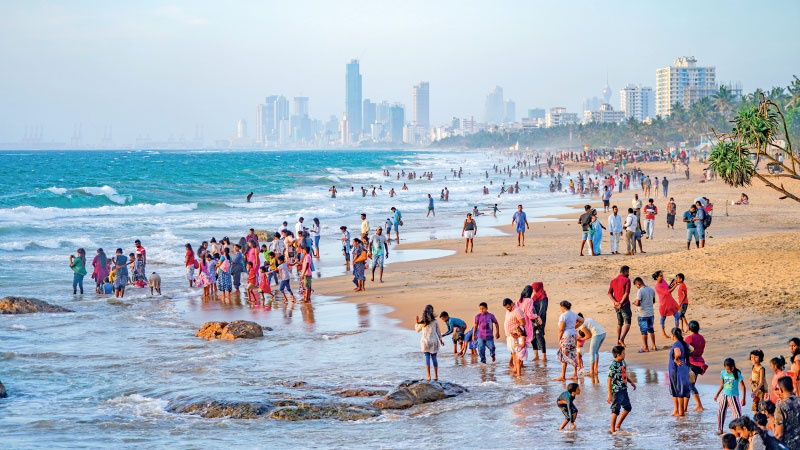Thursday Apr 03, 2025
Thursday Apr 03, 2025
Thursday, 3 April 2025 01:52 - - {{hitsCtrl.values.hits}}

The economy of Sri Lanka would greatly benefit from an increase in tourists
|
 The tourism industry in Sri Lanka has been a strong contributor of foreign capital and, economically, has triumphed over numerous downturns. The economy suffered greater losses during the 2023 recession, but the foreign exchange reserves improved with a 23.2% annual increase in tourists in March 2025. The new report released by the Sri Lanka Tourism Board Data states that the country has recorded 684,960 arrivals this year, which is an increase of 17.6%. That dramatic increase has improved the income generated by the tourism sector.
The tourism industry in Sri Lanka has been a strong contributor of foreign capital and, economically, has triumphed over numerous downturns. The economy suffered greater losses during the 2023 recession, but the foreign exchange reserves improved with a 23.2% annual increase in tourists in March 2025. The new report released by the Sri Lanka Tourism Board Data states that the country has recorded 684,960 arrivals this year, which is an increase of 17.6%. That dramatic increase has improved the income generated by the tourism sector.
Additionally, in February 2025, the gross services inflows reached $ 664.5 million, increasing the foreign exchange reserves for Sri Lanka. Due to tourist spending, Sri Lanka achieved a national income increase of $ 367 million. This shows the need for cooperation from both the public and private sectors to ensure the economy is stable, foster growth, and stimulate competition. A gap in travel purposes and fluctuations of international exchange rates, coupled with exports and remittances, make tourism one of Sri Lanka’s top three foreign currency generators. The nation made $ 2.265 billion in February 2025 and gained a surplus of $ 701 million after paying for imports.
Export earnings stood at over $ 1 billion, while 897 million came from migrants’ remittances and paid services like tourism. The retail trade, accommodation and transport sectors have benefited, to some extent, from the rapid growth of one of the other inflow gross services areas: tourism.
Monitoring tourism industry crucial
The most remarkable increase in revenues from visitors was recorded from November to February, and this is also reflected in the consumption expenditure and imports. The constant monitoring of the tourism industry is crucial in order to reap the benefits while avoiding adverse imbalance problems and ensuring the sustainability of developments. With the Government backing expansion, mid- to large-scale plans for public sector projects are available, and widespread frameworks and supporting laws are paving the way for investments.
The economy of Sri Lanka would greatly benefit from an increase in tourists. Therefore, the Government must work towards boosting this sector as it promises growth within businesses in the area. In the 2025 tourism promotion budget, destination marketing is allocated Rs. 500 million, aimed at diverse tourists through incisive advertising and non-seasonal marketing. A Government cannot spend unwisely, so putting in place an open and effective digital ticketing system can monitor the business and thereby prevent wasteful expenditure.
There has also been massive funding directed at the development of basic infrastructure facilities. The construction of the Bandaranaike International Airport, to which Japan gave assistance, was expected to raise the number of visitors and create links with other terminals. This was the most remarkable turning point.
Tourism-restraining factors
Sri Lanka is utilising more readily approachable tourist locations that are made more accessible by the Government with the improvement of airport facilities and traffic systems. However, there are some problems even with this progress.
The company is not able to realise its best performance because of high domestic flight prices, no direct international flights to other countries, and unnecessary Government bureaucracy. Other tourism-restraining factors include poorly defined policies and inadequate investment thresholds for private sector participation.
There is a gap for private sector funding and participation in the economy. The economy of Sri Lanka is integrating international investors, travel agencies, and large hotel chains, which makes the tourism sector more attractive and aids in its further development. Sri Lanka has yet to reap the rewards of investment into high-value travel sectors of luxury vacations, adventure tourism and eco-tourism.
Sri Lanka lags behind regional competitors Thailand, Vietnam, and Indonesia. Taking, for example, Thailand, its aggressive marketing and infrastructure alongside open policies regarding visas have greatly contributed to the $ 9 billion conglomerate spending within the first quarter of 2024. There has also been growth in short-term and long-term tourism sites made possible by public-private partnerships, which is the case in Indonesia.
Despite some initiatives being funded by the Government, there are sometimes issues such as bureaucratic inefficiencies and a lack of finances that hold Sri Lanka back. To maximise foreign tourism, the country has to encourage the formation of more privatised businesses. Incentives are directed towards enhancing international investment by making international lease agreements and business regulations less complicated.
Other industries will also have to hire more workers to keep up with the demand. The hotel industry uses prospective policies and their impacts during the booming Asian tourism industry. Sri Lanka needs to catch up with other Asian countries and take advantage of the revenue from tourism and foreign exchange.
Digital ticketing a fantastic step forward for Sri Lanka
Modernised Thailand opened its borders to tourists without visas and saw a 23% surge in tourists in the first six months of 2023. Tourists are able to switch effortlessly between cashless and digital payment options, including e-visa. The introduction of digital ticketing is a fantastic step forward for Sri Lanka, but more can be done through online travel services and e-visa applications. Various ecotourism initiatives and PPPs are being implemented in Indonesia.
Private investors can develop spa resorts, eco-tourism resorts, and even historical sites due to the flexibility offered by Indonesia’s tourism infrastructure, which is managed through the Public-Private Partnership (PPP) model. Given the abundance of natural resources and a deeply rich cultural history along with its wealth, Sri Lanka stands the chance of attracting both ecotourism and tourists who are interested in the preservation of historic sites. $ 1.5 billion will be invested in tourism marketing and global branding, with the hopes of achieving it by the year 2024.
For the promotion of tourism, Rs. 500 million has been set aside by the Government of Sri Lanka. It is perhaps more optimistic than realistic, given that further headway could still be made by means of digital initiatives, smart partnerships, and other forms of social capital. These are major problems, along with the stability of financing and the implementation of any new policies. Otherwise, the Central Bank has to be more cautious in terms of monetary policy if there is an increase in tourism, encouraging more foreign currency to flow into the country.
The current import increase in December 2024 is a result of unsustainable credit expansion, which serves as a warning about the dangers of unchecked money infusions. To maintain operations in the country, Sri Lanka’s tourism industry requires stable exchange rates, favourable financial regulations, and a sound, long-term debt-management strategy.
Future of Sri Lankan tourism
Finally, what is the future of Sri Lankan tourism? The tourism sector continues to expand, as does its contribution to foreign exchange reserves, which impacts the economy positively. The increase in tourism and digitisation, coupled with airport development, indicates the Government’s support for the industry. To continue this growth, we need to improve infrastructure, guarantee funding, and enforce compliance with legal frameworks. The private sector can take over by issuing straightforward investment guidelines, fast-tracking the issuance of permits, and providing substantial funding.
Sri Lanka can enhance its tourism brand, identify lucrative niche markets, and increase international competitiveness by learning from Vietnam, Thailand, and Indonesia. With Government support and business collaboration, Sri Lanka’s tourism sector can sustain its current growth rate and achieve economic stability in the future. It was initially this discovery that placed the country as one of the most prestigious destinations to visit in Asia.